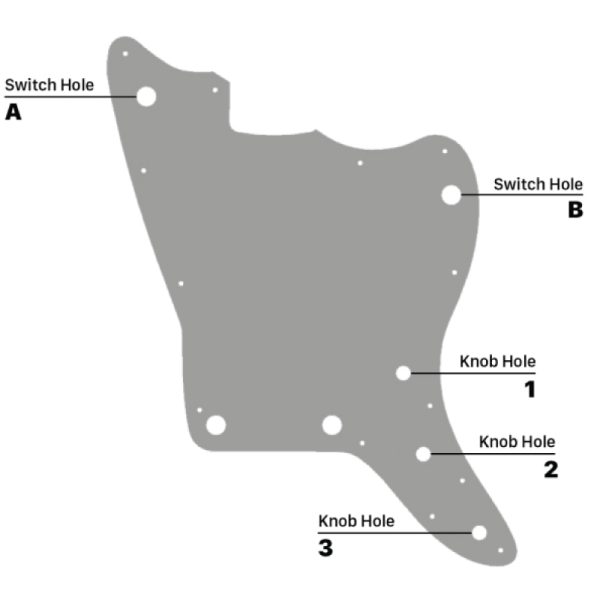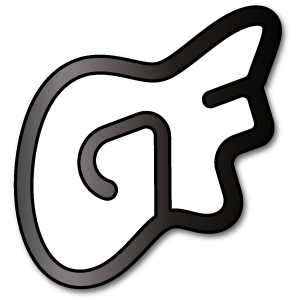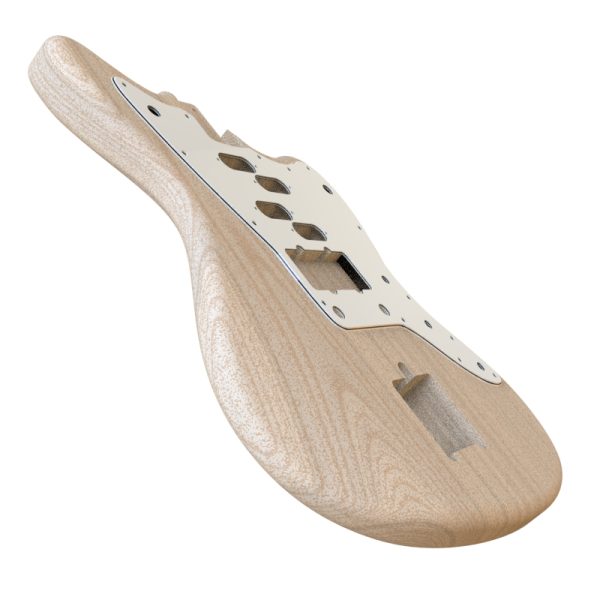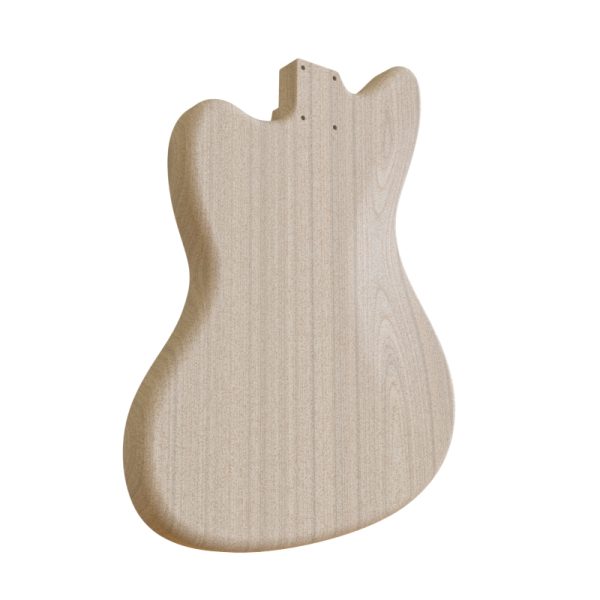Base price:
Joyrider
£279.00
Compatibility
When vintage-correct pickup and bridge options are selected, our Joyrider body is compatible with an AVRI-pattern pickguard.
When the pickups or bridge routes deviate from vintage spec, a GuitarForm pickguard is required to guarantee the pickup holes line up to the routes in the body.
The Joyrider is compatible with a 25-1/2″ scale neck and can be specified with either an S-Style or T-Style neck pocket.
If you would like the “Switch Hole A” position to feature traditional Rhythm Circuit controls, please select “None” and write “Rhythm Circuit” in the “Message” section at the bottom of the builder.
Our bridge thimble holes are likewise routed to accept AVRI diameter thimbles, and as noted above, the vibrato route is compatible with any standard or retrofit offset vibrato with vintage-spec plate pattern and mounting holes.
Note: we do not drill the holes in the body for the pickguard screws, vibrato mounting plate screws, pickup mounting screws, strap button screws or grounding wire to the bridge thimbles. We can drill between the treble-side thinline cavity and the vibrato cavity at no extra cost for a grounding wire to the vibrato – please make a note of this in the “message” section and we will be happy to oblige.
Pickguard Configuration


Features & Options
Contours
The thinline contours are what we describe as “full depth” – they are identical to the contours on our solidbody Joyrider and Jugular bodies, which is to say they are generally a little deeper in the arm and a little shallower in the belly than most vintage contours (though size, shape and depth of vintage contours varied widely in different years and even from instrument to instrument in the same year). Our preference is for smooth, melty contours that don’t exhibit a prominent edge / line where they meet the flat surface of the body, and we pay as much attention to how they combine and sculpt the edge of the body as we do to the faces.
Whilst their smoothness makes them more subtle in appearance than some contours, we make up for this by maximising the surface area – our belly contour makes up over 21% of the area of the guitar back (compared to less than 9% as measured on a body made by our largest competitor). Our arm contour angle is more vertical (follows the bass-side pickguard edge more closely) than on an S-style guitar, just like the originals, and this allows for the area of this contour to be maximised without conflicting with the vibrato plate location (which must, of course, be mounted fully on a flat surface).
Quality of Life
Additionally, we make a few “quality of life” improvements:
1. We leave little bumps under the top surface beneath the pickguard screw locations, so your screws will have plenty of material to bite into (though special care must always be taken on Thinlines to drill the screw holes generously and prevent over-tightening of the screw, especially where the location is adjacent to a cavity edge).
2. We make a weight relief chamber under the vibrato location, though only in the back half of the guitar body, in order that the vibrato plate mounting screws are well seated.
3. The vibrato cavity itself is routed with a “dog bone” on the back edges so you can place the vibrato optimally without having to worry about the trem knocking, forcing you to chisel out the back corners of the route square. The extra routing does not conflict with the mounting screw holes and is covered by a vintage-style vibrato plate.
4. We can cut a square heel-adjust truss rod nut access channel as a no-cost option. If you want this, please indicate so in the “message” field.
5. Our Thinline Joyrider body comes as standard with a neck pocket angled at 1.1°, so a shim should not be required for the bridge to sit at a suitable height.
Angled Neck Pocket
An angled neck pocket allows increased break angle over the bridge – a necessity when using modern string gauges, and the main culprit for buzzing and string skipping issues. Even the much maligned Vintage-style bridges can function quite happily with the correct angle and slightly heavier strings.
It is beneficial to increase the break angle at the neck-end before the tail-end; the reason being that if all the angle is behind the bridge, due to the way it ‘floats’, this will force the bridge forward and cause problems returning to pitch. It is also the case that there are more hazards to the string behind the bridge than in front – for instance, the chance of the string fouling against the back edge of the bridge plate, intonation adjustment screw heads, or against the mounting screws on the plate.
To a large extent, this is why common “solutions” to the break angle problem like the BuzzStop or moving the vibrato unit closer to the bridge can cause more problems than they solve. As such, it is preferable to introduce as much angle as possible at the neck-end before worrying about what’s going on behind.
From its origins as a flagship Jazz guitar, through a misunderstood period marked by prominence in the counter-culture, towards its eventual recognition and acceptance on its own terms; this model’s legacy was never static, and was never guaranteed.
Love it or hate it, the original instrument is characterised almost entirely by its unique bridge and vibrato design.
It was vital to our mission that we offer the most practical and configurable platform possible without compromising the bridge pickup position or compatibility with vintage or AVRI pickguards. Whether you use this power to swap the bridge to a preferred option, or to experiment with the original foundation by combining different pickups; or even to take advantage of our many small quality-of-life improvements that make your dream vintage-style instrument come to life, you can trust that a GuitarForm Joyrider has your needs covered.










